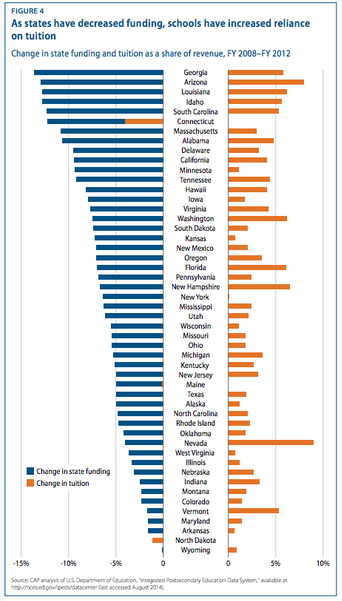It’s safe to say that almost everyone agrees that the price of higher education in the United States is far too high. Although 44% of college students opt to attend a more affordable community college, tuition prices have been steadily increasing over the years due to a lack of state funding. In fact, according to College Board, the price of going to community college for two years has increased by 250% in the past 30 years. As you can see in the chart below, there is a primarily negative correlation between changes in education spending and changes in tuition costs: as states lose funding on education, their average tuition costs increase.
The increase in price of colleges deters lower and sometimes middle-income students from attending college, which yields the severe economic stratification in higher education that we see today.
During president Obama’s State of the Union address, and earlier on January 8th, he proposed a government program to make two-year community college free for students across the country. It would cover all tuition costs for both part and full-time students who maintain a 2.5 GPA, and would give students the credits to eventually transfer into a 4-year university or an occupational training program if they so desired. Three quarters of the funding would come from the federal government, and participating state governments would fund the rest. This idea was inspired by the Tennessee Promise, which has currently drawn 58,000 applicants, which is about 90% of this year’s high school seniors. If all states were to participate, it is estimated that the program could cover approximately 9 million students and save them an average of $3,800 per year.
Education is considered a mixed good: it has qualities of both a public and private good. For definition’s sake, a good is private if it demonstrates both rivalry (if one person consumes it, it is no longer available to somebody else) and excludability (if someone doesn’t pay for it, they can’t have it), while a public good is non-rival and non-excludable. It is like a private good in the sense that it is rivalrous and excludable, but it yields positive externalities to society as well. When someone receives a college education, not only does the person benefit through improved job prospects and higher potential wages, but the benefits also spill over to the community due to an increase in overall productivity. If nine million U.S. citizens became more eligible to work in specialized and demanded job fields, it would both increase GDP at a higher rate and make the U.S. even more competitive in the global economy.
Of course, the proposal of free community college comes with some economic criticism. Opponents have argued that this policy will bring unintended consequences to students going to a four-year college or university. The cost of a regular Bachelor’s degree depends heavily on the revenue obtained by larger entry-level classes enrolled by first and second year students. If more students opt to go to community college for free their first two years, the cost of universities’ tuitions will go up. This means that a student who wants to continue at a university to get more advanced training with upper division classes might end up paying as much, if not more, than if they simply went to a college or university of all four years. That being said, not all students benefiting from free community college education will desire or have the financial means to continue with a Bachelor’s degree, so the advantages and disadvantages are more complicated to analyze than what meets the eye.
Although Obama’s proposal comes with both benefits and costs, it is refreshing to hear about a potential national policy that revives the rhetoric of the long dead American Dream. Of course, any actual bill regarding his proposal would have almost a very low chance of clearing our currently republican-dominated congress, but it is a progressive endeavor that should be considered more at the state level.

